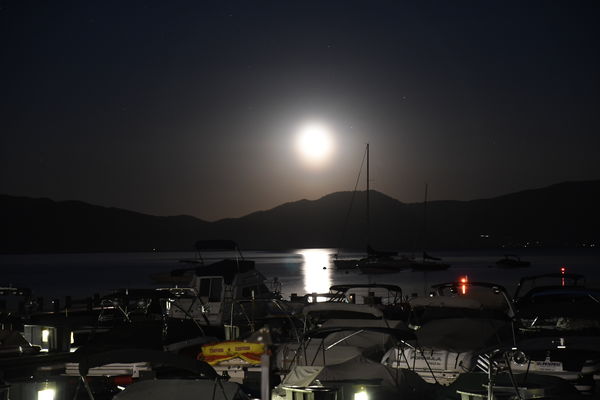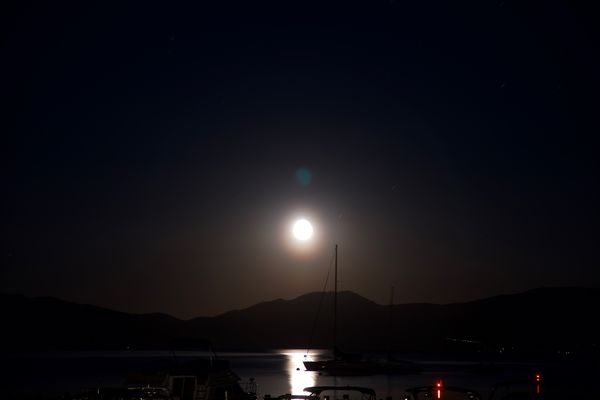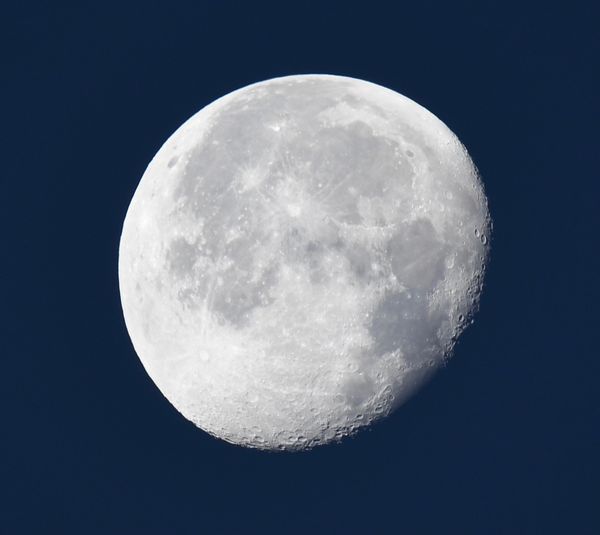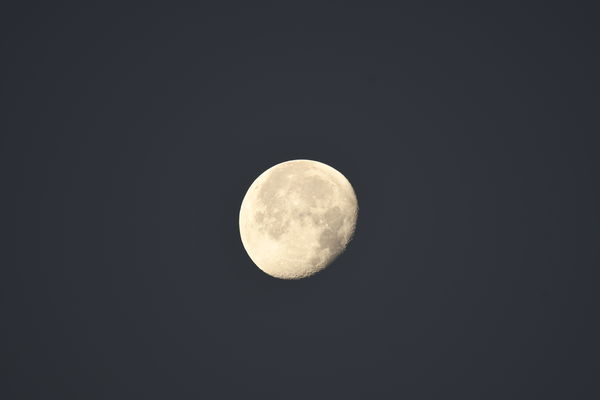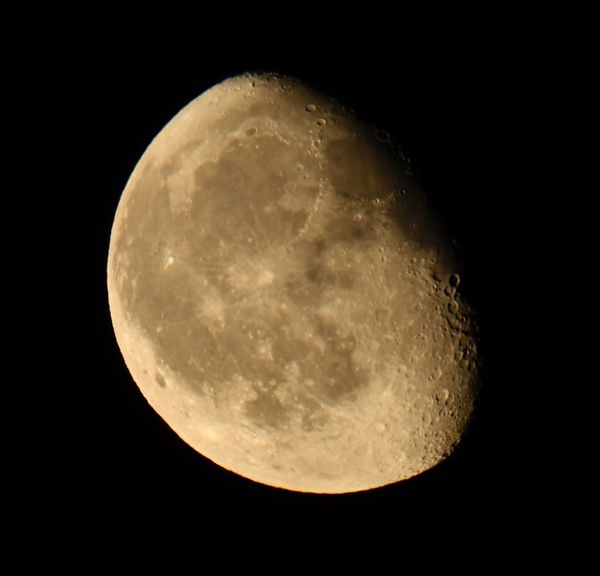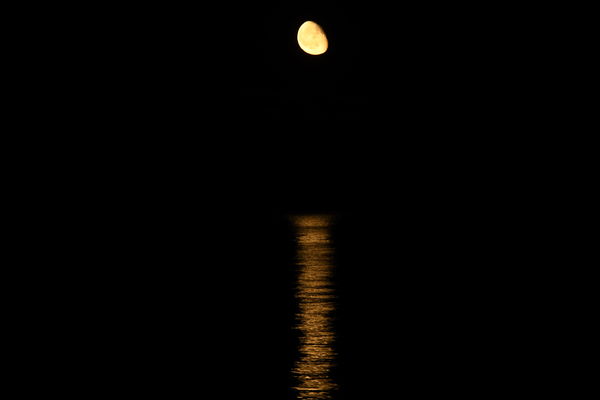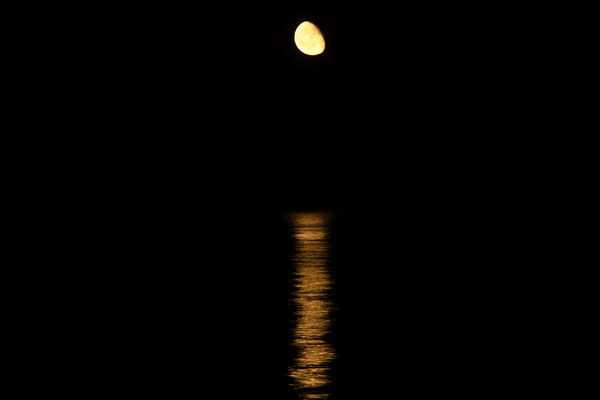More Moon Question
Jul 2, 2018 18:20:54 #
I use Nikon D500 and last night while here in Lake Tahoe I tried to shoot the moon just as it was above the horizon and was displaying a beautiful reflect upon the lake in a ver yellowish color, However every shot i took left the moon virturly white. I shot with the Apeture wide open and closed, with shutter speeds from under 1 second to 30 seconds, and the ISO anywhere from 100 to 10,000 plus, the only thing I did not adjust was the white balance which was set to Auto, perhaps I should have set this to one of the settings on the Camera, Incondesant lighting perhaps, I am going to try again this evening to get this shot with the approriate color so any suggestion, and or techincal support would be greatly appreciated. I want to thank all in advance for you help in this matter please see attached photos. and a little more clarity and ot detail of the moon would be nice aswell. The later moon shots were from the other night with a completely different lens, am I comparing apples to oranges, Or?
Jul 2, 2018 18:26:34 #
Jul 2, 2018 18:28:57 #
Your first two images are an issue with exposure. I'm not sure what your metering mode was in taking those two, but they are over exposed. Spot metering on the moon is the best starting point. Once you have the spot metered exposure, increase it by one and then two stops. See which of the two you like best, or suits your camera best.
--Bob
--Bob
dyximan wrote:
I use Nikon D500 and last night while here in Lak... (show quote)
Jul 2, 2018 18:29:33 #
Your metering method?
In the telephoto you probably have a more accurate meter because of the larger moon.
In the first, the moon is small.
You can't use averaging with moon shots if you want the detail in the moon. Averaging takes the WHOLE frame and comes up with an average, which will over expose the moon, because most of the frame is dark.
I spot meter on the moon. If I can't, I expose for a normal daylight shot, starting with f/8 and 1/250 and adjust from there.
And yes, everything else will be dark.
In the telephoto you probably have a more accurate meter because of the larger moon.
In the first, the moon is small.
You can't use averaging with moon shots if you want the detail in the moon. Averaging takes the WHOLE frame and comes up with an average, which will over expose the moon, because most of the frame is dark.
I spot meter on the moon. If I can't, I expose for a normal daylight shot, starting with f/8 and 1/250 and adjust from there.
And yes, everything else will be dark.
Jul 2, 2018 18:43:46 #
rmalarz wrote:
Your first two images are an issue with exposure. I'm not sure what your metering mode was in taking those two, but they are over exposed. Spot metering on the moon is the best starting point. Once you have the spot metered exposure, increase it by one and then two stops. See which of the two you like best, or suits your camera best.
--Bob
--Bob
That being said I would want to go to my metering menu and set it to center weighted at say 6mm as I have 6/8/10/13/and AVG and not AVG, would the number of focal points help or hinder in this scenario aswell
Jul 2, 2018 19:16:14 #
dyximan wrote:
I use Nikon D500 and last night while here in Lak... (show quote)
Remember, you are shooting reflected sunlight. You are "dragging your shutter" too much. Speed it up, way up.
Jul 2, 2018 19:17:22 #
Center weighted is good, but spot (if your camera has that mode) would be best. I'd also suggest the center focal point, but suspect that the focal points are not going to affect metering.
Also, manual mode might work better for you, as well. That way the exposure won't change from the time you meter the moon and then recompose the photo to be what you'd like compositionally.
--Bob
Also, manual mode might work better for you, as well. That way the exposure won't change from the time you meter the moon and then recompose the photo to be what you'd like compositionally.
--Bob
dyximan wrote:
That being said I would want to go to my metering menu and set it to center weighted at say 6mm as I have 6/8/10/13/and AVG and not AVG, would the number of focal points help or hinder in this scenario aswell
Jul 2, 2018 19:22:24 #
Use F8 or f11 at 20th iso 100 . I own a D500 and love it but it will over expose and blow out your highlights. So caution to the dark side. Don't shoot the moon wide open o a D500. If you use a 200-500 at 500mm then you may have to use 500th or higher to keep it fast . Also you can shoot two shots one the moon in good contrast and the other expose for the forground the paste the good moon over the e blown out one. Try it its cool.
Jul 2, 2018 19:38:38 #
dyximan wrote:
That being said I would want to go to my metering menu and set it to center weighted at say 6mm as I have 6/8/10/13/and AVG and not AVG, would the number of focal points help or hinder in this scenario aswell
6mm may work. I'm not familiar with a size connotation. (I don't have that option.)
If you want the moon in focus, you might consider one point focus, or set it manually.
Experiment to see what works best for your rig.
Jul 2, 2018 21:34:42 #
You treat the moon like daylight, since that what it is, reflected daylight.
Use the old standby LOONEY 11 RULE:
The “looney 11 rule” states that for photos of the Moon’s surface, set aperture to f/11 and shutter speed to the (reciprocal of the) ISO setting.”
With ISO 100, set the aperture to f/11 and the shutter speed to 1/100 or 1/125 second.
With ISO 200, aperture at f/11, set shutter speed to 1/200 or 1/250.
With ISO 400, aperture at f/11, set shutter speed to 1/400 or 1/500
Use the old standby LOONEY 11 RULE:
The “looney 11 rule” states that for photos of the Moon’s surface, set aperture to f/11 and shutter speed to the (reciprocal of the) ISO setting.”
With ISO 100, set the aperture to f/11 and the shutter speed to 1/100 or 1/125 second.
With ISO 200, aperture at f/11, set shutter speed to 1/200 or 1/250.
With ISO 400, aperture at f/11, set shutter speed to 1/400 or 1/500
Jul 2, 2018 22:03:18 #
rgrenaderphoto wrote:
You treat the moon like daylight, since that what ... (show quote)

I’ve even used this for eclipse photos on a point and shoot camera.
Andy
Jul 2, 2018 23:31:35 #
Longshadow wrote:
6mm may work. I'm not familiar with a size connotation. (I don't have that option.)
If you want the moon in focus, you might consider one point focus, or set it manually.
Experiment to see what works best for your rig.
If you want the moon in focus, you might consider one point focus, or set it manually.
Experiment to see what works best for your rig.
I just googled spot metering and found out how to find it and utilize it, thank you, But would have never thought to look it up without the advice from you and others here thanks to all who’ve helped and responded. New photos tomorrow I hope.
Jul 3, 2018 03:40:21 #
I want to thank all of you again for your help, now I will have to learn how to PP so I can get better definition of the moon and merge it with the reflection. The spot metering was the ticket.
Jul 3, 2018 07:11:54 #
rgrenaderphoto wrote:
You treat the moon like daylight, since that what ... (show quote)
The correct answer.
It is futile to meter the moon. Lunacy!
 You will alway get the same reading if your spot meter is small enough.
You will alway get the same reading if your spot meter is small enough. Sunny 16 places the moon around middle gray. Loony 11 makes it one stop brighter.
Jul 3, 2018 09:44:02 #
gvarner
Loc: Central Oregon Coast
Start with the Sunny 16 Rule stopped down one or two stops and check your histogram. Getting the moon properly exposed will leave the foreground underexposed. An ND filter would help to expose for the foreground too if that's what you want.
If you want to reply, then register here. Registration is free and your account is created instantly, so you can post right away.
